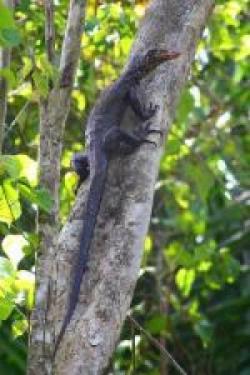Just weeks after scientists announced the discovery of a new monitor lizard in the Philippines, researchers have uncovered another unknown monitor inhabiting Southeast Asia. Described in Zootaxa, the new torch monitor (Varanus obor) is found only on the tiny island of Sanana, in the western Moluccan islands of Indonesia.
The new monitor lizard, named ‘Torch’ for its bright orange head which tops a black body, reaches almost four feet in length, a little smaller than the other recently-discovered monitor Varanus bitatawa from the Philippines. Researchers say the torch monitor in fact a close relative of Varanus bitatawa .
Inhabiting the coastal sago palm mangrove forests on Sanana, the torch monitor is the only monitor species to have evolved red coloring.
 The new torch monitor (Varanus obor) . Photo by: Valter Weijola. |
Researchers believe that since no predatory mammals live on the eastern side of Wallace Line—a biological demarcation first set out by explorer-biologist Alfred Russell Wallace—big reptiles like the torch monitor, which feeds on small animals and carrion, have taken the place of top predator.
“There are more [monitor] species there, doing more different things ecologically than in Africa or South and Southeast Asia, where competition and predation by mammals tend to keep monitor lizards down. East of Wallace’s Line in Indonesia, New Guinea, and Australia, monitor lizards are on the top of the heap. It emphasizes again how little we know about some tropical regions, to find an animal so strikingly colored and so large only last year,” says Sam Sweet, a professor in the department of Ecology, Evolution and Marine Biology at UCSB, in a press release.
An expert on monitors, Sweet worked Valter Weijola, a graduate student at Abo Akademi University in Turku, Finland, to describe the species. Weijola discovered it a year ago.
The largest family member of the monitor lizards is the infamous Komodo dragon, also endemic to Indonesian islands.
Related articles
Photo: Fruit-eating dragon discovered in the Philippines
(04/07/2010) Scientists have discovered a new species of giant lizard in the unlikeliest of places: a highly populated, deforested landscape in the Philippines.
Forgotten species: the subterranean Gekko gigante
(04/08/2010) Travelers to tropical destinations are likely familiar with the gecko. Clinging to walls and ceilings of buildings—sometimes staring down at you from the bedroom ceiling or glancing at you quizzically from the bathroom door—the small adhesive-footed lizard could be aptly described in some tropical areas as ubiquitous. Despite the apparent commonness of some species, geckos are delightful lizards with round wide eyes, a thick gripping tongue, and of course that amazing knack of seemingly defying gravity with specialized toe pads. But not all geckos are as easily found—or as common—as those hanging out, literally, in a jungle lodge. The Gekko gigante, also known as the Gigante narrow-disked gecko, has been little- noticed by the public. Even scientists know little about the lovely gray-and-blue gecko beyond the fact that it lays its eggs on cool moist cave walls in two Philippine Islands.
Photo: Camouflage expert discovered in Cambodia
(03/25/2010) Researchers have discovered a cryptic species of gecko in the Cardamom Mountains of Cambodia, reports Fauna & Flora International (FFI), a conservation group that operates in the region.
